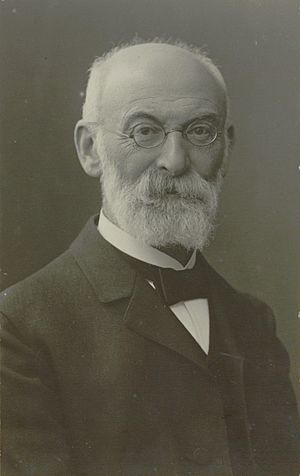Moritz Pasch facts for kids
Moritz Pasch (born November 8, 1843, in Breslau, Prussia – died September 20, 1930, in Bad Homburg, Germany) was an important German mathematician. He was especially interested in the basic ideas and rules of geometry. He earned his Ph.D. from the University of Breslau when he was only 22 years old. Later, he taught at the University of Giessen, where he helped many students get their own doctorates.
Why Moritz Pasch Was Important
In 1882, Pasch published a book called Vorlesungen über neuere Geometrie. In this book, he argued that the rules of Euclidean geometry needed to be made much clearer and more exact. He believed that mathematicians should be very careful about how they used logic to prove things.
Improving Euclid's Ideas
Pasch pointed out that even the famous ancient Greek mathematician Euclid had made some "hidden assumptions" in his book, Elements. These were ideas that Euclid used without clearly stating them as rules. Pasch thought that mathematical thinking should not depend on how we imagine things physically. Instead, it should only rely on formal rules and axioms (basic truths) that are clearly written down.
Pasch's ideas were very influential. His book became a starting point for:
- Other mathematicians, especially in Italy, who also wanted to make geometry more precise.
- The work of David Hilbert, another famous mathematician, who developed new ways to think about geometry and mathematical rules in general.
- Almost all modern ideas about the basic rules of Euclidean geometry.
Pasch's Axiom Explained
Moritz Pasch is perhaps best known for something called Pasch's axiom. An axiom is a statement that is accepted as true without proof. Pasch's axiom helps to define what it means for points to be "between" other points on a line.
He explained it like this: If you have three points that don't lie on the same straight line (like the corners of a triangle), and you have a separate line that doesn't go through any of these three points, then:
- If this separate line crosses the space between two of your points, it must also cross the space between one of the other two pairs of points.
Think of it this way: If a straight line cuts through one side of a triangle, it must also cut through one of the other two sides of that same triangle. It can't just stop in the middle of the triangle or cross only one side.
See also
 In Spanish: Moritz Pasch para niños
In Spanish: Moritz Pasch para niños
- Pasch's theorem
- Pasch hypergraph
- Ordered geometry


